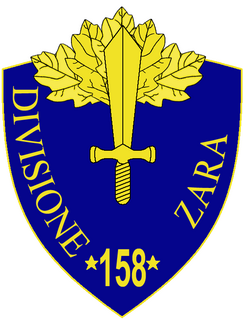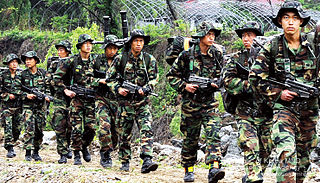80th Infantry Division La Spezia was an Airlanding Division of the Italian Army during World War II. The La Spezia was formed in 1941, for the planned Invasion of Malta. When the invasion was cancelled the Division was instead transferred to Libya in October 1942. In December it was reinforced by a battalion of the San Marco Marines and additional artillery. It suffered heavy losses during the Battle of the Mareth Line in Tunisia in March 1943 and the surviving elements surrendered in May 1943.

The 16th Infantry Division Pistoia was an auto-transportable infantry division of the Italian Army during World War II. It was created by dividing the infantry division "Fossalta" in 1939. The Pistoia was classified as an auto-transportable division, meaning staff and equipment could be transported on cars and trucks, although not simultaneously.

The 103rd Infantry Division Piacenza was a auto-transportable Infantry Division of the Italian Army during World War II. The Division was formed in 1942, and was in the Italian Fourth Army's XXII Corps that was part of the occupying Italian army in France, located in the Toulon area. At the end of August 1943, the Italian High Command decided to move the 4th Army from southern France back to Italy, where it was destroyed fighting the Germans after the Italian Surrender in September 1943.

The 104th Infantry Division Mantova was a auto-transportable Infantry Division of the Italian Army during the Second World War..

The 105th Infantry Division Rovigo was a auto-transportable Infantry Division of the Italian Army during World War II. The Rovigo was classified as an auto-transportable division, meaning staff and equipment could be transported on cars and trucks, although not simultaneously. The Division was mobilized in March 1942, and took part in the Italian invasion of Vichy France, as part of the Italian I Corps. It then returned to Italy and surrendered to the German forces in September 1943, after the Italian armistice.

The 31st Infantry Division Calabria was an infantry division of the Italian Army during World War II. The Calabria Division, formed from the 31st Infantry Brigade "Caprera" 15 October 1939, was part of the garrison at Sardinia where it remained until it surrendered to the Allies after the Italian surrender in September 1943. The Division would then serve on the Allied side until the end of the war.

The 38th Infantry Division Puglie was a mountain infantry division of the Italian Army during World War II. The Puglie Division was mobilized 15 May 1939 and disintegrated soon after 8 September 1943. The division filled its ranks with men drafted in eastern Veneto and Friuli, with a majority of soldiers hailing from the towns of Sacile and Vittorio Veneto. The only difference between line infantry divisions and mountain infantry divisions was that the latter's artillery was carried by pack mules instead of the standard horse-drawn carriages. Italy's real mountain warfare divisions were the six alpine divisions manned by the "Alpini" mountain troops.

The 61st Infantry Division Sirte was an auto-transportable Infantry Division of the Italian Army during World War II. The Sirte Division was formed 9 May 1937 in Misrata, and destroyed 23 January 1941 east of Tobruk. The Sirte was classified as an auto-transportable division, meaning staff and equipment could be transported on cars and trucks, although not simultaneously.

The 49th Infantry Division Parma was an infantry division of the Italian Army during World War II. The Parma Division was a regular division of the Italian Army, formed 12 September 1939 in Macerata, and dissolved 8 September 1943 in Vlorë.

The 51st Infantry Division Siena was a regular infantry division of the Italian Army during World War II. The Siena Division was formed 15 September 1939 and dissolved 8 September 1943. Historically a Campanian unit, it was made almost entirely of Neapolitans.

The 53rd Infantry Division Arezzo was a mountain infantry division of the Italian Army during World War II. It was formed 24 May 1939 and officially dissolved 12 September 1943. The Arezzo division is not related to partisan division Arezzo operating in 1943 in the Cortona vicinity under command of Siro Rossetti. The only difference between line infantry divisions and mountain infantry divisions was that the latter's artillery was carried by pack mules instead of the standard horse-drawn carriages. Italy's real mountain warfare divisions were the six alpine divisions manned by the Alpini mountain troops.

The 158th Infantry Division Zara was a regular infantry division of the Italian Army during World War II. The Zara Division formed in March 1942, was a garrison division stationed on the Dalmatian coast. It surrendered to the Germans after the Italian surrender to the Allies in September 1943.

The 151st Infantry Division Perugia was an infantry division of the Italian Army during World War II. The Perugia Division was formed in August 1941 as a garrison division. It was sent on operations to Yugoslavia in December 1941. It was part of the Italian forces committed to the Battle of the Sutjeska. It was then transferred to Albania in August 1943. Following the Italian surrender in September 1943, the division marched from Girokaster to the Albanian coast, where some thousand men could be evacuated by ship to Italy, but the majority was left behind and was largely captured by the Germans of the 99 regiment, I Mountain Division, at "Porto Palermo". The commander of the "Perugia", gen. Ernesto Chiminello, was shot on October 4, 1943, at 16:45; the next day the other 120 officers were shot on the beach of "baia Limione" and their bodies were thrown in the sea. The last 32 officers, after fierce resistance, were captured near Kuc and shot there on the morning of October 7, 1943. Some survivors from the division joined the partisans, many others dispersed and tried to hide and survive in the woods; Bill Tilman reported in October 1943 that some 5,000 survivors from the "Perugia" and "Parma" Divisions were "living on roots and berries".

The 56th Infantry Division Casale was a regular Infantry Division of the Italian Army during World War II. It was formed in 1939 in Forlì and was dissolved in September 1943 in Aetolia-Acarnania region of Greece. The majority of its men originated from Romagna.

The 57th Infantry Division Lombardia was a regular infantry division of the Italian Army during World War II. It was formed on 24 May 1939 in Pula and disbanded on 8 September 1943.

The 152nd Infantry Division Piceno was an infantry division of the Italian Army during World War II. The Piceno Division was a Garrison division, formed in August 1941. As it was station in Italy it was also used for coastal defence. It was disbanded by the Allies after the Italian surrender in September 1943.

The 153rd Infantry Division Macerata was an infantry division of the Italian Army during World War II. The Macerata Division was a Garrison Division formed in December 1941. In June 1942, it was transferred to Slovenia and later moved to Croatia in May 1943, where it conducted anti partisan operations. It was located around Delnice in Croatia when it was captured by the German forces following the Italian surrender to the Allies in September 1943.

The 155th Infantry Division Emilia was an infantry division of the Italian Army during the Second World War, formed in December 1941 as a garrison division. Despite this, in April 1942 it was sent to Dalmatia to assist in combat operations against Yugoslav Partisans. After the Italian armistice with the Allies of September 1943, most of the division surrendered to the Germans, but some elements held out until October, while the 155th Artillery Regiment managed to cross the Adriatic to reach Apulia in Southern Italy, where it joined forces with the 104th Motorised Division Mantova.

The 156th Infantry Division Vicenza was an infantry division of the Italian Army during World War II. The Vicenza was formed in January 1942 as a garrison division. It was then sent to the Eastern front, as part of the Italian Army in Russia to act as a reserve, behind the front on "line of communications", rear area security and anti-partisan duties. Then in July 1942, it was sent into the front line, where it was overrun and destroyed in the Soviet offensive of December 1942-January 1943. Of 10,466 men in the division, 7,760 were killed or missing.






















